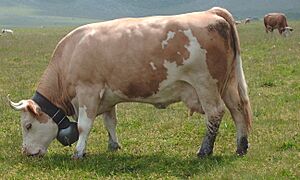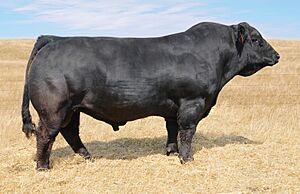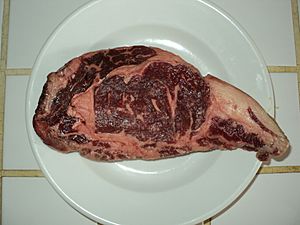Simmental cattle facts for kids
The Simmental or Swiss Fleckvieh is a special kind of cattle breed. It comes from Switzerland. These cows are named after the Simmental valley, which is near the Simme river. This valley is in the Bernese Oberland region of Switzerland. Simmental cattle are usually reddish with white patches. People raise them for two main things: their milk and their meat. They are known for being strong and useful animals.
Contents
History of Simmental Cattle
Where Simmental Cattle Started
Simmental cattle are one of the oldest and most widespread cattle breeds in the world. People have known about them since the Middle Ages. These cows were so good that they helped create many other famous European breeds. Some of these include the Montbeliarde in France and the Fleckvieh in Germany and Austria.
Simmental Cattle in Africa
Simmental cattle first arrived outside Europe in Namibia in 1893. They came to South Africa in 1905. In these countries, they are called "Simmentaler." They are mostly used for producing beef. Farmers like them because they are great for crossbreeding. This means mixing them with other breeds. This helps create cows that give lots of milk or strong calves for meat.
Simmental Cattle in the Soviet Union
In the past, the Simmental was a very important cattle breed in the former Soviet Union. About one-quarter of all cattle there were Simmental. Farmers mixed them with local cattle to create six new types. These types were named after the regions where they were developed. For example, there was the Steppe Simmental and the Ukrainian Simmental. In 1990, there were almost 13 million Simmental cattle in the Soviet Union.
Different Names for Simmental Cattle
This breed is known by many different names around the world:
- Fleckvieh Simmental: Used in Argentina.
- Simmental: Used in many countries like Australia, Canada, France, Ireland, the United States, and Switzerland (for the SI-division).
- Fleckvieh: Used in Austria, Germany, the Netherlands, and Switzerland (for the SF-division).
- Simmentaler: Used in South Africa and Namibia.
- Local names: Countries like Croatia, Czech Republic, and Hungary have their own names. These often mean "spotted cattle."
- Pezzata Rossa: This is the name used in Italy.
- Montbéliarde: This is a French dairy breed. It is part of the European Simmental Federation.
Characteristics of Simmental Cattle
Traditional Uses
Historically, Simmental cattle were used for many things. They provided milk and beef. They also worked as draught animals, meaning they pulled carts or farm equipment. They are famous because their young grow very quickly. This happens if they get enough food. Simmentals are known for giving a good amount of both milk and growth in their calves.
Appearance in Africa
In Namibia and South Africa, only Simmentaler cattle with specific colors are registered. They must have colors from dark red or brown to yellow. These colors can be in any pattern on their body. They also need some white on their forehead and lower legs. Solid black or solid red animals are not registered there.
Types of Simmental Cattle
The Simmental-Fleckvieh breed has many different types. No other breed has so much variation. These types are bred for different purposes:
- Dairy type: These are like special dairy breeds. An example is the Swiss Fleckvieh, which gives a lot of milk.
- Dual-purpose with focus on milk: These cows produce milk, but also have good meat qualities.
- Truly dual-purpose: These cows are milked, and their bulls gain weight very well for meat.
- Moderate beef type: These are used for raising calves for meat. They are often found on large ranches.
- Extreme beef type: These are bred mainly for meat, like other special beef breeds such as Charolais. They are usually very large.
The traditional color of Simmental cattle is "red and white spotted" or "gold and white." However, there is no single standard color. The main color can range from a light yellow-gold to a very dark red. Dark red is popular in the United States. Their face is usually white. This white face often appears in their calves, even when mixed with other breeds. This white face is different from the white head of the Hereford breed.
Images for kids
-
A Swiss Simmental entrecôte steak
See also
 In Spanish: Simmental (raza bovina) para niños
In Spanish: Simmental (raza bovina) para niños







